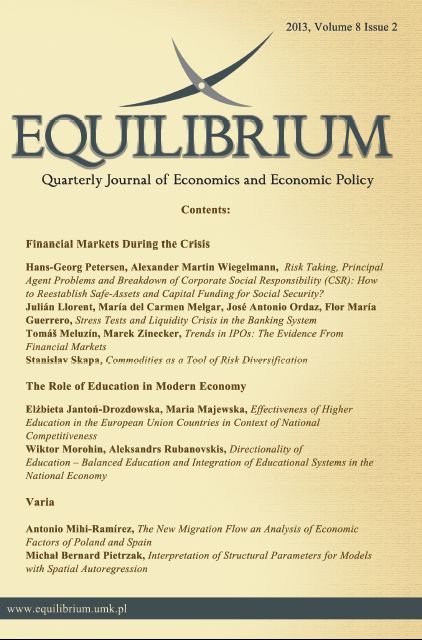Effectiveness of Higher Education in the European Union Countries in Context of National Competitiveness
DOI:
https://doi.org/10.12775/EQUIL.2013.015Keywords:
effectiveness of education, national competitivenessAbstract
The main aim of this paper is to present the results of comparative analysis of higher education effectiveness in the European Union countries in the context of technology adoption and knowledge development. The first part of the paper describes the notion of national competitiveness, the determinants of its improving and methods of its measuring. Enhancing national competitiveness is in fact one of the objectives of higher education in the welfare economies, or should be in the countries that want to become such. That is why our attempt to verify the higher education effectiveness is taken from the perspective of performance, such as competitiveness. Furthermore, the welfare economy will be very difficult to achieve without a well-educated and trained workforce that is able to absorb new knowledge in order to introduce innovations to market. Today's educational systems should thus provide the so-called knowledge workers who endowed with the relevant knowledge resources can apply them in practice. These workers are a strong factor under pinning national competitiveness. The second part focuses on the comparison of higher education effectiveness in the 27 European Union countries on the basis of selected indicators presented in the World Economic Forum?s annual Global Competitiveness Reports. Our study covers the five years period between 2008 and 2012 and is carried out to evaluate the effectiveness of higher education in European Union countries using indirect measures such as the opinion of entrepreneurs about the quality of higher education; the indicators of knowledge absorption capacity; and the extent of cooperation between universities and business. In this part of the paper our own synthetic index of higher education effectiveness is also presented which takes into account, according to the main aim of the paper, the issue related to technology adoption and knowledge development.
Downloads
References
Archibugi D., Coco A. (2004), A new Indicator of Technological Capabilities for Developed and Developing Countries, ?World Development?, No. 4. DOI: http://dx.doi.org/10.1016/j.worlddev.2003.10.008
Coe D.T., Helpman E., Hoffmaister A.W. (1997), North-South R&D Spillovers, ?The Economic Journal?, No. 107. DOI: http://dx.doi.org/10.1111/1468-0297.00146
IMD World Competitiveness Yearbook (2012), Lausanne.
Innovation Scorecard. Country Innovation Profiles (2012), Milken Institute, Santa Monica.
Innovation Union Scoreboard 2011 (2012), Enterprise and Industry, European Commission.
Jantoń-Drozdowska E. (1998), Competitiveness of Poland?s Economy in View of its Integration with the European Union, [in:] A. Zielińska-Głębocka, A. Stępniak (eds.), EU Adjustment to Eastern Enlargement. Polish and European Perspective, Editors: Fundacja Rozwoju Uniwersytetu Gdańskiego, Gdańsk.
Jantoń-Drozdowska E. (2009), Międzynarodowe stosunki gospodarcze, Ars boni et aequi, Poznań.
Jantoń-Drozdowska E., Majewska-Bator M. (2011), Wiedza techniczna jako źródło przewagi konkurencyjnej kraju, [w:] H. Babis, R. Czaplewski (red.), Drogi dochodzenia do społeczeństwa informacyjnego. Stan obecny, perspektywy rozwoju i ograniczenia, Tom I, ?Zeszyty Naukowe Uniwersytetu Szczecińskiego?, nr 650, ?Ekonomiczne Problemy Usług?, nr 67.
Majewska-Bator M., Jantoń-Drozdowska E. (2007), International knowledge spillovers and the importance of human capital in this process: empirical research for Poland [in:] W. M. Grudzewski, I. Heiduk, S. Trzcieliński (red.), Organizations in Changing Environment. Current Problems, Concepts and Methods of Management, IEA Press, Madison.
Nezeys B. (1993), La compétitivité international, Economica, Paris.
Porter M. (1980), Competitive Strategy. Techniques for Analyzing Industries and Competitors, The Free Press, New York.
Porter M. (1990), The Competitive Advantage of Nations, The Free Press, New York. DOI: http://dx.doi.org/10.1002/cir.3880010112
Regional Innovation Scoreboard 2012, Enterprise and Industry (2012), European Commission.
Rosenberg N. (1982), Inside the Black Box: Technology and Economics, Cambridge University Press, Cambridge.
Sachwald F. (1994), Competitiveness and Competition: Which Theory of the Firm? [in:] F. Sachwald, E. Elgar (red.), European Integration and Competitiveness. Acquisitions and Alliances in Industry, Aldershoot.
Stimulating Economies through Fostering Talent Mobility (2010), World Economic Forum in collaboration with The Boston Consulting Group, Geneva.
The Global Competitiveness Report 2008-2009 (2008), World Economic Forum, Geneva.
The Global Competitiveness Report 2012-2013 (2012), World Economic Forum, Geneva. Urban S. (1993), Managément international, Edition Litéc, Paris.






